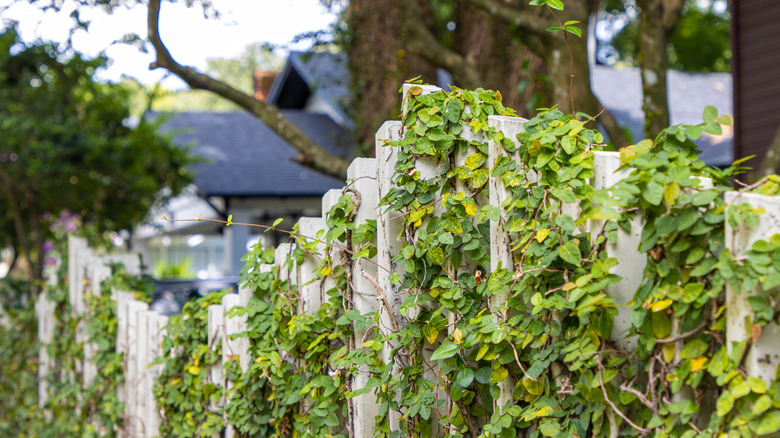What To Do If A Neighbor Grows An Invasive Plant Near Your Property
It's frustrating to put time and effort into curating a healthy, balanced yard only to discover that a neighbor is cultivating an invasive species next door. While plants such as bamboo, English ivy, or kudzu wouldn't be a problem if they stayed put, they tend to spread aggressively, crowding out native species, and can quickly overtake fences, flowerbeds, and entire laws. If the plant is located in your neighbor's yard, you might feel unsure about how to respond without creating unnecessary conflict. The first step is almost always the simplest: open communication with the neighbor in question. Most people don't realize that it is complicated to choose between native and non-native species and a polite conversation may inform them that their plants could potentially be harming the environment.
Start by approaching your neighbor with curiosity rather than confrontation. You can mention that you notice the plant growing near your property line and express concern about the potential for spread. Sharing resources—such as articles from your local extension office or conservation department—might help them understand the risks. If they're receptive, you might even suggest cooperative solutions, such as installing root barriers, trimming the plant regularly, or replacing it with a less aggressive, potentially native alternative.
It can be difficult for some homeowners to tell the difference between invasive plants and aggressive growers, but with a nudge in the right direction, you might be able to handle the situation without escalation. Your neighbors might even be willing to work with you once they discover that the invasive species is causing long-term damage to surrounding properties, and their own yards. By starting the dialogue off respectfully, you're more likely to achieve a cooperative outcome and maintain friendly neighbor relations.
What to do if the plants are causing damage
Unfortunately, not every situation can easily be resolved with a friendly conversation. If you're dealing with a problematic invasive plant that has already moved onto your property and is causing damage—whether it's strangling trees, cracking pavement, or reducing biodiversity—you may need to take more serious steps. Begin by documenting the spread with photos, noting dates, and keeping records of conversations you've had with your neighbor, either digitally or in person. This can establish a clear timeline of events should you need to escalate the matter legally.
From there, you can attempt physical control methods such as installing proper barriers, cutting back growth, or carefully applying herbicides on your side of the property line. Try to get to the invasive species before they start seeding within your garden, as it may take a few seasons to entirely rid the space of these pesky plants. These measures require an annoying amount of diligence, but they can slow the spread while you seek longer-term solutions.
If the situation continues or the plant is considered a high-risk invasive species in your region, reach out to local conservation organizations, invasive species task forces, or your county extension office. These groups can provide guidance, resources, and in some cases, direct intervention. In extreme cases, you might need to consult with local municipal codes or property laws, particularly if the invasive species is listed as prohibited in your state. Some municipalities allow homeowners to file complaints or request official removal notices when invasive species threaten ecosystems or wildlife in the area. While these steps are definitely more formal, they exist to protect both property owners and the environment. Handling the problem carefully, and with proper documentation, ensures that you are taking the responsible route while still defending your property from long-term harm.

